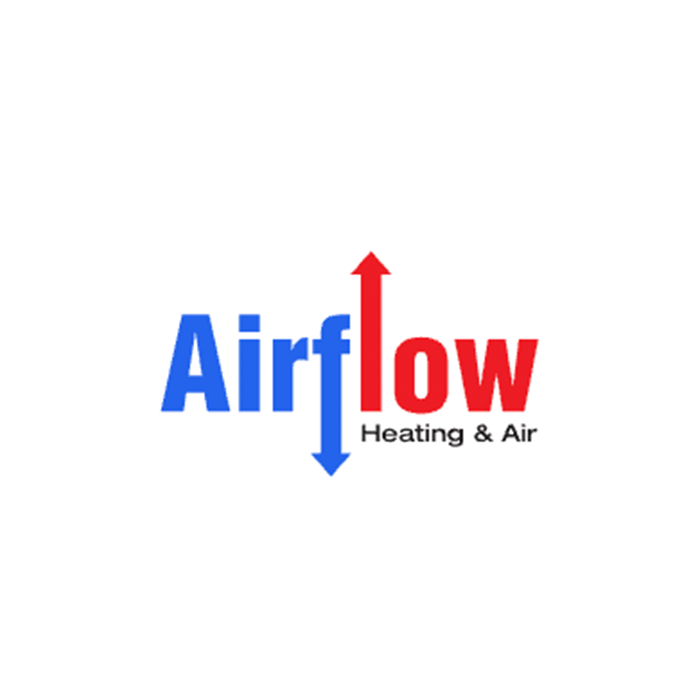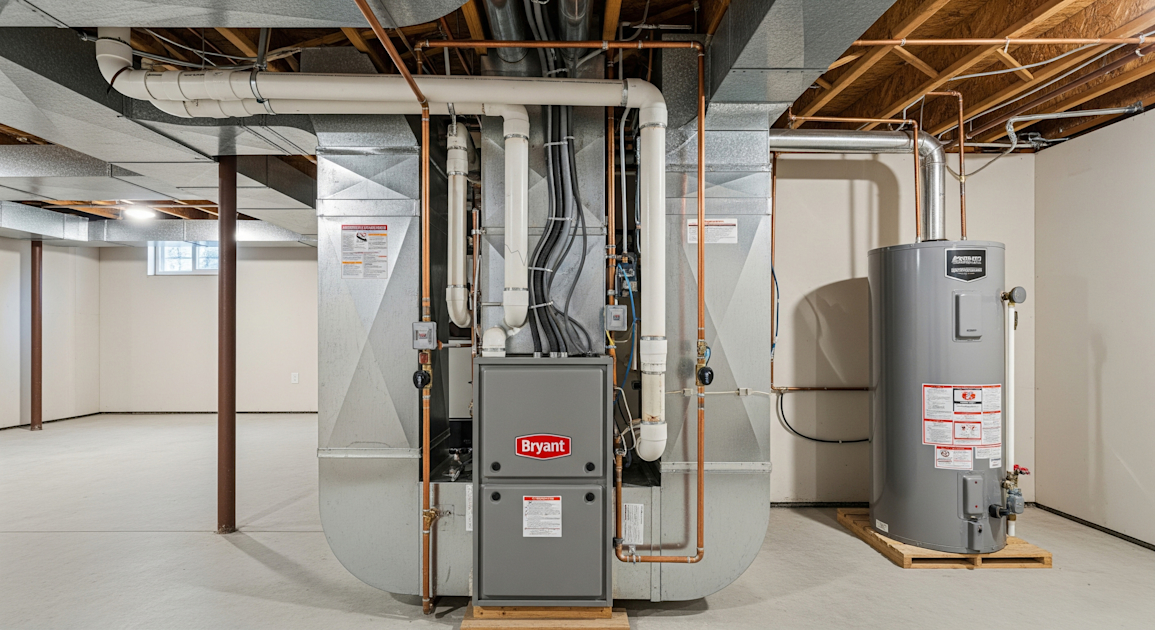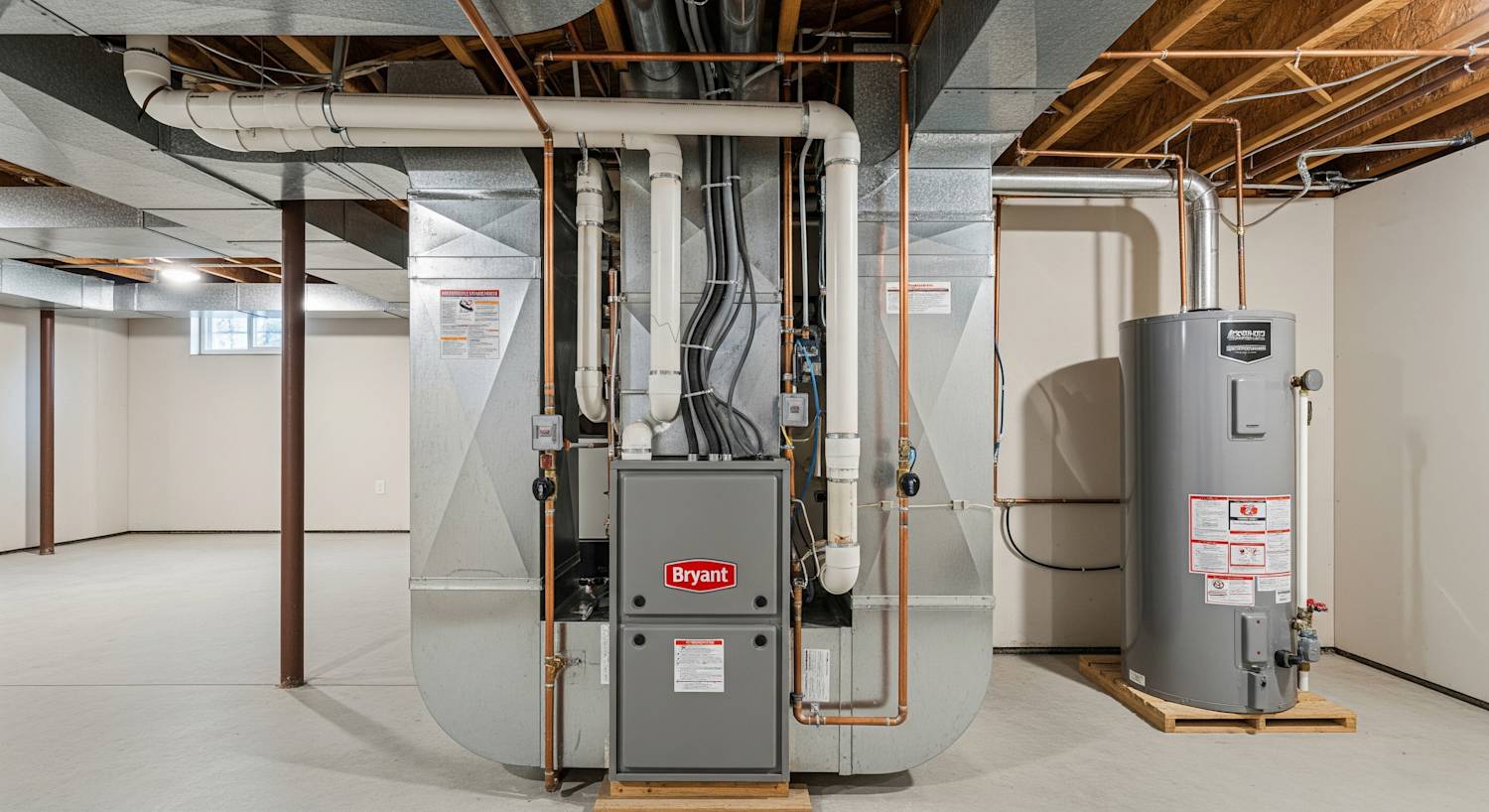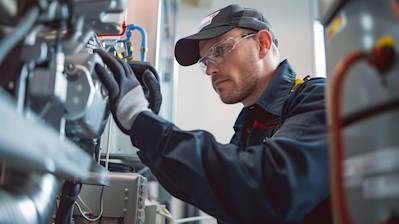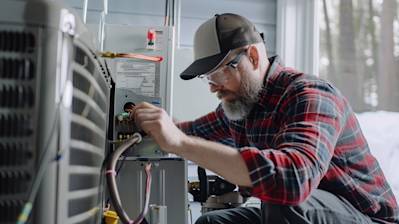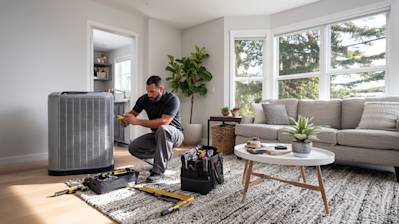As an essential component of your HVAC system, a heat exchanger is responsible for tranferring heat from one medium to another. While a well-maintained heat exchanger can deliver peak performance for many years, wear and tear, coupled with other factors, can lead to a cracked heat exchanger. Let's delve deep into the causes, symptoms, implications, and rectification of a cracked heat exchanger.
What is a Heat Exchanger?
Before discussing a cracked heat exchanger, we first need to understand what a heat exchanger is. It's an integral part of your furnace which resembles a series of loops or coils. It's where the combustion happens and it's responsible for:
- Absorbing heat from the furnace's combustion process.
- Transferring this heat to the air blown across it by your system's blower.
For your safety and the efficiency of your system, the heat exchanger must remain sealed from the air that's heated and circulated throughout your home.
Causes of a Heat Exchanger Crack
There are several reasons a heat exchanger might crack, which include:
- Old Age: The older your heating system, the higher the probability of your heat exchanger cracking as metal fatigue sets in.
- Frequent Cycling: The constant heating and cooling cycles can lead to a thermal stress, which eventually results in cracking.
- Overheating: If your furnace's airflow is obstructed or if it is oversized for your home, it might overheat and cause the heat exchanger to crack.
- Improper Venting or Combustion: These may cause the heat exchanger's metal to corrode, resulting in cracks over time.
Symptoms of a Cracked Heat Exchanger
Knowing how to identify a cracked heat exchanger keeps your home safe and your furnace functioning optimally. Here are some signs:
- Odd Smells: If your furnace emits a strong smell of formaldehyde, it's a clear sign of a cracked heat exchanger.
- Stale Air or Excessive Dryness: A cracked heat exchanger often leads to stale air and excessive dryness in the home.
- Discolored Metal: Look for signs of soot or steel turning rusty or deformed.
- Physical Illness: Frequent headaches, nausea, and other signs of carbon monoxide poisoning may suggest a cracked heat exchanger.
The Implication of a Cracked Heat Exchanger
A cracked heat exchanger should be treated with utmost urgency, as it poses severe risks:
- Risk of Carbon Monoxide Poisoning: As the heat exchanger cracks, it can leak carbon monioxide, an odourless yet deadly gas.
- Decreased Efficiency: When a crack occurs, your furnace’s response is to work even harder, leading to decreased energy efficiency.
- Cost implications: Operating your system with a cracked heat exchanger can lead to further damages and increasing costs in repair or even replacement of the whole system.
How to Prevent Your Heat Exchanger from Cracking
You can take preventive measures to extend the lifespan of your heat exchanger and avoid cracking:
- Schedule regular professional furnace inspections and maintenance services.
- Replace your air filters on a regular basis.
- Ensure proper installation of the furnace system that matches the size of your home for optimal operation.
Frequently Asked Questions about Cracked Heat Exchanger
What Are Some Signs of Cracked Heat Exchangers?
Cracked heat exchangers often cause peculiar smells, like a strong metallic or formaldehyde scent. You might also notice changes like a decrease in efficiency, frequent system cycling, or even odd sounds coming from your furnace. If you notice any of these indicators, it might be time to get your heat exchanger inspected for cracks.
Can a Cracked Heat Exchanger Cause Carbon Monoxide Leakage?
Yes, it can. A crack in your heat exchanger can create an open pathway for carbon monoxide to leak into your home. This is the primary hazard associated with cracked heat exchangers. It's critical to have carbon monoxide detectors in your home and to ensure your heat exchanger is routinely inspected to prevent this potentially lethal situation.
Is a Cracked Heat Exchanger Dangerous?
A cracked heat exchanger could pose a serious risk if not addressed promptly. Because heat exchangers are a key part of your furnace system, any damage can adversely affect the overall operation of your heating system. Notably, a cracked heat exchanger could lead to carbon monoxide leakage, which is seriously harmful and can be fatal.
How Do I Repair a Cracked Heat Exchanger?
Repairing a heat exchanger is no easy task and is best left to professionals. Since the heat exchanger is integral and complex, even minor mistakes during repairs could lead to serious implications. Furthermore, in some situations, the crack might be too severe that replacement rather than repair becomes necessary.
What Causes a Heat Exchanger Crack to Expand?
Once a crack forms on a heat exchanger, it usually tends to grow larger over time. This is due to the constant heating and cooling cycles which the heat exchanger undergoes, leading to the metal expanding and contracting. Over time, these movements can cause a small crack to expand and cover a larger portion of the heat exchanger.
How Much Does It Cost to Replace a Cracked Heat Exchanger?
The cost of replacing a heat exchanger essentially depends on the type and size of your furnace. On average, you might be asked to pay anywhere from $1,000 up to $2,000, including the cost of the new unit and labor expenses. Some companies may offer a lower price depending on different factors like discounts, model, or any current promos they might be offering.
How Long Does It Take to Replace a Cracked Heat Exchanger?
The process of replacing a cracked heat exchanger can take anywhere between 3-6 hours, on average. However, this can vary greatly depending on the type of heat exchanger, the complexity of your furnace system, and the level of skill and experience of your HVAC technicians.
Can I Prevent Heat Exchanger Cracks?
Yes, preventive measures can be taken to lessen the possibility of heat exchanger cracks. Regular maintenance and timely repairs can keep your furnace and its parts, including the heat exchanger, in good working condition. An annual inspection by a professional is an effective way to ensure any potential issues are spotted and addressed promptly.
Can a Cracked Heat Exchanger Affect My Energy Bill?
A cracked heat exchanger could lead to inefficient functioning of your heating system. This means your furnace could be working extra hard to reach your desired temperature, which in turn can lead to an increase in energy consumption and subsequently, an increase in your energy bill.
Cons of a Cracked Heat Exchanger
Decreased Efficiency
A cracked heat exchanger significantly impacts the overall efficiency of your heating system. The heat exchanger's core function is to transfer heat from one medium to another without letting them mix. For instance, in a furnace, the exchanger pulls in cool air, heats it up, and then redistributes it around your home. A crack, however small or large, interrupts this delicate process and hence the furnace needs to use more energy to heat your room, leading to increased utility bills.
Release of Dangerous Gases
The most serious consequence of having a cracked heat exchanger is undoubtedly the potential release of carbon monoxide (CO) into your home. As part of the combustion process, furnaces create this deadly gas, which the heat exchanger usually confines within its walls, expelling it safely out through the vent pipe. However, even a tiny crack gives this colorless and odorless 'silent killer' an escape route into your living area where it can cause serious health problems for the building's occupants.
Increased Repair or Replacement Costs
When a heat exchanger suffers a crack, an HVAC technician will need to replace or repair it which can cost hundreds, and at times, thousands of dollars depending on the age and model of the furnace. It might also force you to replace the whole furnace if the cracked heat exchanger is too difficult or too expensive to replace.
Decreased Lifespan of Your Heating System
A cracked heat exchanger puts disproportionate stress on an HVAC system. The accurate transfer of heat is compromised and your furnace works harder to compensate, accelerating general wear and tear. This could potentially shorten the overall lifespan of your heating system, requiring a costly premature replacement.
Negative Impact on Indoor Air Quality
Cracked heat exchangers also negatively impact the indoor air quality, beyond the release of carbon monoxide. The cracks can enable the combustion gases to mix with ductwork or conditioned air which can lead to circulation of pollutants and irritants throughout your home. Indoor air contaminants can cause or exacerbate allergies, asthma, skin irritation, and other respiratory issues.
Heat Loss
A cracked heat exchanger loses heat in the flue gasses, meaning that not all the heat generated is used to heat your home. You end up consuming more fuel than necessary, ultimately leading to increased energy bills.
Frequent On-and-off Cycling
When your heat exchanger cracks, your HVAC system detects something isn't right which may cause it to turn on and off more frequently than it would under normal operation. Not only does this lead to higher energy use, but it also leads to unusual wear and tear on the system's other components.
Reduced Comfort
Lastly, a busted heat exchanger can cause uneven heating within your space, leading to cold spots or even overall cooler temperatures. A comfortable, cozy, and warm indoor environment during cold winter months is vital, and a cracked heat exchanger could greatly compromise this comfort.
Pros of a Cracked Heat Exchanger
In reality, there are no benefits or 'pros' to having a cracked heat exchanger. Your concern should quickly shift to addressing, repairing, or replacing a heat exchanger that has a crack or other damage. The potential risks to energy efficiency, safety, health, and comfort are too great to ignore.
Myths and Misconceptions about Cracked Heat Exchanger
Having a heat exchanger for your HVAC system at home or office isn't uncommon but several misconceptions and myths about having a cracked heat exchanger breaches into the scene, causing incorrect diagnoses and wrong judgments. Understanding these in detail can light you up with the real scenarios, bringing out facts and setting aside the fluffs.
Myth 1: Cracked Heat Exchanger will Automatically Lead to Carbon Monoxide Poisoning
This particular myth tops the list. People often live in fear thinking a cracked heat exchanger will automatically start emitting Carbon Monoxide (CO). While a cracked exchanger can indeed emit CO, it doesn't really imply that every cracked exchanger will do so.
The Reality
CO emission often requires an improper combustion process. A flawless combustion process turns gas into water vapor and carbon dioxide, while an imperfect one can create carbon monoxide as by-product. However, the presence of a crack does not always interfere with the combustion process. Therefore, automatically assuming CO emission from every crack is wrong.
Myth 2: You can Diagnose a Crack just through Visual Inspection
Many users believe they can identify a cracked exchanger simply with visual inspection.
The Reality
In reality, these cracks may not always be apparent visually. The crack might have developed inside the heat exchanger that's inaccessible for a naked-eye inspection or it might be so minute that you easily miss noticing it. Therefore, relying only on visual inspection is misleading.
Myth 3: Cracked Heat Exchangers Always Need Replacement
This is another common misapprehension, where people are made to believe that every cracked heat exchanger has to be replaced immediately.
The Reality
A cracked heat exchanger does require attention, but it does not necessarily have to be replaced every time. Depending on the size and location of the crack, sometime repairs can be made to extend its effective life. Remember, replacement is always an option, but it's not the only one.
Myth 4: Sealants can Permanently Fix the Cracks
There's a misconception that simple sealants or adhesives can permanently mend the cracks of a heat exchanger.
The Reality
Temporary sealants can indeed provide a temporary solution, but cracks, especially those which are results of thermal fatigue due to constant heating and cooling, tend to reappear. Hence, considering sealants as a permanent fix is not advisable.
Myth 5: All HVAC Professionals can Properly Identify and Repair a Cracked Heat Exchanger
Many believe that every HVAC professional is adept enough to detect and fix a cracked heat exchanger.
The Reality
The diagnosis and repair of a heat exchanger require experience and proficient knowledge. Some HVAC professionals might lack this experience or might intentionally misinform you to sell a replacement.
Myth 6: Cracked Heat Exchanger only Appears in Old Units
The myth here is that the heat exchangers in newly installed units are immune to cracks.
The Reality
While it is true that heat exchangers in older units are more susceptible to develop cracks due to prolonged usage, it does not mean that new units are totally defenseless. The quality of the installation, usage pattern and the environment where it’s installed, all can contribute to an early cracking.
By debunking these myths, your understanding of heat exchangers can be based on facts rather than misconceptions. This information can be helpful for proper maintenance, avoiding potential risks and unnecessary expenses related to your HVAC system's heat exchanger.
Summary
So, what happens when you have a Cracked Heat Exchanger in your home or commercial HVAC system? Basically, you're opening up the system to potential leaks, which can allow harmful gases to enter your living or working space. Plus, a cracked heat exchanger compromises the efficiency of your heating system, leading to increased energy costs and possibly even failure of the entire system.
A cracked heat exchanger is a serious issue and should be addressed as soon as possible. It's not just about staying warm during the cold winter months but also about maintaining a safe and healthy environment in your home or workplace. Regular inspections and maintenance by a professional can play a big role in preventing such problems to begin with.
Don't wait until it's too late to pay attention to your heat exchanger. Remember, a cracked heat exchanger can lead to potential health risks and higher energy bills. If you notice any signs of trouble, get in touch with professional help ASAP. They'll be able to diagnose and fix the problem before it can do any real damage.
About AirFlow Heating & Air
At AirFlow Heating & Air, nestled in the heart of Sacramento, CA, we take great pride in offering top-tier climate control solutions to our happy customers. With our team’s unwavering commitment to first-rate service, we ensure that each client breathes easier in their comfortable spaces, be it offices or homes. Striving for excellence, we blend cutting-edge technology with our gritty, hands-on approach. It’s not just about temperatures for us; it’s the warmth of relationships that we build along the way that makes our day! Experience, quality, and impeccable service aren’t just buzzwords for us; they’re what keep us flowing.
